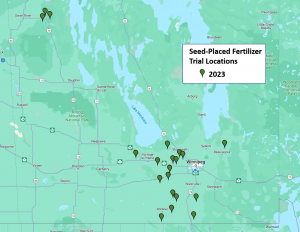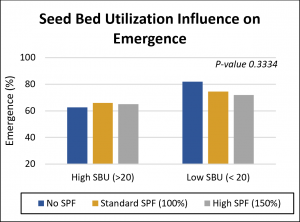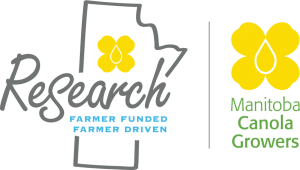Canola Seed-Place Fertilizer Toxicity Trial
Research Question: Are seed-placed fertilizer (SPF) applications being used across Manitoba safe for canola plant establishment and what are the major factors influencing seed safety?
Treatments
- No Seed-Placed Fertilizer
- Standard Seed-Placed Fertilizer Rate (100%) – Farm Normal
- High Seed-Placed Fertilizer Rate (150%)
Trial Setup: In this trial each location has one replicate of each treatment. This is to allow for a wider range of testing environments (soil/rainfall), equipment (row spacing, opener type, seed bed utilization) and agronomic practices (seed-placed fertilizer sources, rates, blends). Allowing for examination of the relationships between these testing factors and seed safety (emergence).
Data Collection: Plant Counts (4 leaf), Emergence %.
Click here to see full protocol.
Preliminary Results (Year 1)
Summary of 2022 – 2023 Trial Results
- Overall, there was a slight, non-significant, reduction in emergence as seed-placed fertilizer increased from zero to the high rate of 150% of the farms standard practice.
 Locations with low SBU (<20%) included all of the sites that were seeded using planters, resulting in higher initial emergence than locations with high SBU (>20%) when no SPF was applied.
Locations with low SBU (<20%) included all of the sites that were seeded using planters, resulting in higher initial emergence than locations with high SBU (>20%) when no SPF was applied.- When SBU was low (<20%) increases in SPF showed a trend of increased seed toxicity (reduced emergence) compared to when SBU high (>20%).
- Each location was categorized based on the farm’s standard SPF rates as low, med, or high fertilizer rate risk based on current recommendations for seed safety.
- High risk = N, P, and S rates are all over the recommended safe levels.
- Medium risk = N, P, or S rates are over the recommended safe levels.
- Low risk = N, P, and S are within the recommended safe level.
- As fertilizer rate risk increase from low to high the overall emergence trended lower.
 The largest reductions in emergence with increased SPF rates were seen at locations that fell into the high fertilizer rate risk category.
The largest reductions in emergence with increased SPF rates were seen at locations that fell into the high fertilizer rate risk category.
The goal of this trial is to be able to use a large data set (target n=100 over four years) to examine relationships between emergence and the factors that influence seed toxicity in canola, such as, spring soil moisture, soil texture, SBU and seed-placed fertilizer rate and sources. After year one we saw that many farms are pushing what are considered “safe” seed-placed fertilizer rates with low SBU. Testing locations in 2023 were concentrated in the Red River Valley with plans to increase testing locations in central and western Manitoba in the following years.

Funded in part by the Governments of Canada and Manitoba under the Sustainable Canadian Agricultural Partnership, a federal-provincial-territorial initiative.
